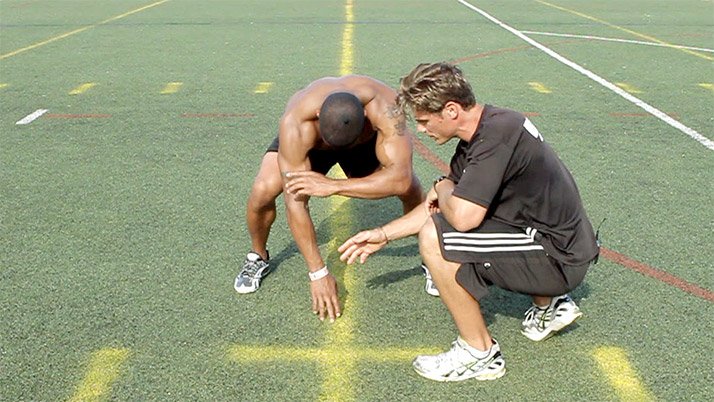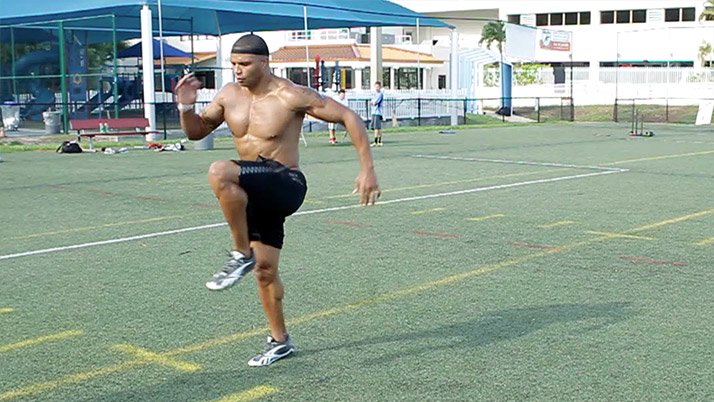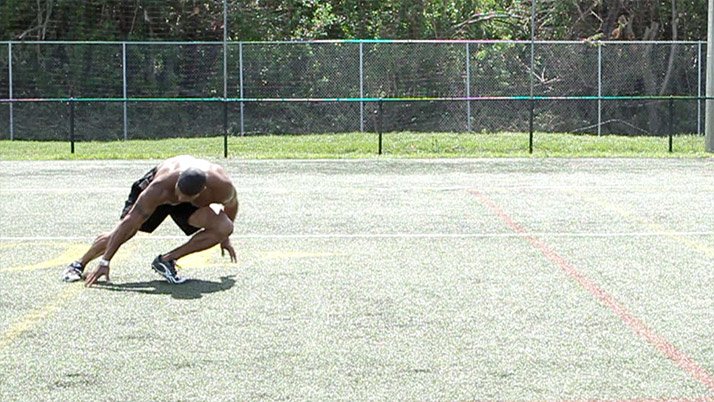
NFL Combine Trainer: Shuttle Run For Agile Acceleration
Elite athleticism comes naturally for few football players. NFL scouts understand this and respect less-gifted players who put in extra work to compete against and beat the complacent elite.
Previous Drill | Overview | Next Drill
The shuttle runs take weight room strength and apply it athletically. The power you built squatting all these years helps you launch yourself forward and sideways, linear and lateral, but only if you have the technique to get you from point A to point B.
NFL Combine Trainer Shuttle Run
Watch the video: 09:35
This drill asks you to prove if you can get in position to make a play in the league. You need to train your body and mind how to move quickly and according to the rules of the NFL shuttle run.
Three particular exercises prepare you for this test of agility, power and athleticism.
The shuttle run at the NFL Combine is based on two simple concepts
- Utilization of lateral power (power potential perpendicular to the line of sight) to break into lateral speed and change direction a full 180 degrees from lateral to linear speed.
- Acceleration through 10 yards with a linear speed change of direction through the finish.
General athleticism is needed for every play in football. NFL veterans are often surprised by how much line-bounding and karioka-stepping is involved in their training. It builds overall athleticism for any move, route or adjustment, but focuses specifically on the shuttle run. These exercises transfer weight room strength to pure athleticism.
Side-Standing Long Jump

They key to perfecting the side-standing long jump is low reps with high sets. Do 2-or-3 jumps to the right and left sides, perform full shuttle runs, come back and do more side-standing long jumps. You don't want to fatigue your nervous system.
The main concept of the side-standing long jump is position. Perform it twice per week with 1-minute rest periods.
- Get hips as low as possible without setting your center of mass back so far that you can't get out of the stance.
- Distribute weight between front and back halves of the feet.
- Head position should be down, with relaxed neck muscles so you don't throw yourself back too soon.
- Use your legs and hips to create lateral power from the start.
Bommarito Perfromance Systems does not teach athletes to lift their heels off the ground before jumping. Feet should be flat to perform a true jump and should leave the ground simultaneously.
You're more powerful this way, and that's where a lot of athletes fail. People error by picking up one foot and turning it; opposed to creating a weight shift from the left foot to the right; using the right foot to propel yourself with both feet laterally. That maximizes your power potential.
How To Perform The Side Standing Long Jump
- Straddle yourself directly over a line.
- Put one hand on the ground with your fingertips barely touching. It should feel light on the fingertips.
- Butt down a little bit and shoulders up slightly. Keep the arm not touching the ground off the knee and relaxed.
- Explode and cover as much ground as possible by lifting your hand and jumping off your feet simultaneously.
Carioca Quick Step

The Carioca quick step simulates coming out of the lateral power motion. You're going to accelerate at high speeds, similar to the start of the side standing long jump. The carioca quick step is a great drill to develop comfort while accelerating off the edges of your feet.
Basic track and field biomechanics is the arms lead the legs (fast and efficient arms lead to more explosive legs). You're overemphasizing the arm action by clearing the hip on the backside and resetting up with a hand punch forward. The benefits of perfecting this exercise will make the first 5-yard lateral run quicker and more efficient. At the same time, because of the arm action, you'll be more efficient at changing direction in the shuttle run or in actual games.
It looks like a simplistic drill, but it's very taxing on the nervous system. Do 6-8 perfect reps on each side and keep them short, perfect and explosive. Take a rest period, repeat again and do more full shuttle runs. Perform this no more than twice per week with one minute rest periods.
How To Perform The Carioca Quick Step
- If you move to the right first, start with your left arm up in a relaxed athletic position.
- With your right foot, quick step behind and pull the knee up. Fire your arms back up when you pull the right knee. Be sure that your knee goes straight up and down.
- Start your lateral run to the side and don't look where you're going. That gives you the tendency to turn the feet. You don't want to turn the feet because it will be harder change direction.
Outside Edge Line Bounding Series

The basic form and technique of the line-bounding series is used to maximize lateral distance (distance traveled in a direction perpendicular to the line of sight).
If you have a line to bound across, don't focus on forward distance. Your goal is to maximize lateral distance. Do this once per week with 2-3 minute rest periods.
How To Perform The Outside Edge Line Bounding Series
- Minimize ground contact, maximize height time and get a yard across the line (2-yard distance) on each bound.
- Once you complete the third bound and jump into the fourth (which is where you accelerate from) hit your edge and get into a squat.
- The eccentric loading component of the hips dictates how much power potential you have, which correlates to change of direction.
- The final component is arm action. As soon as your fingertips touch a blade of grass, do a powerful double-arm pump, just like a Carioca Quick Step.
- It's not always about strength and deceleration components. A lot of the time it's just a comfort level with the edges of the feet. When you change direction, use a strong two-step stop. The inside leg has to decelerate off the outside edge.
- Get comfortable with deceleration components. The components of deceleration are maximized while bounding.
- The rules of the shuttle run dictate that you have to touch one hand down, but not both. Touch the hand by the heel and keep your other hand off the ground. That positions you so you may re-accelerate quickly.
- On the fourth step, stack the feet, tap the outside edge, split your hands and fire your feet into a quick-step karioka. Whip the hands to take you into the acceleration phase.


